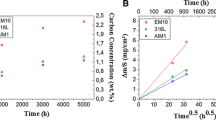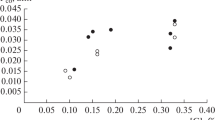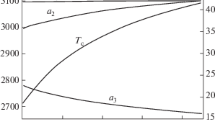Conclusions
-
1.
The foil method is unsuitable for determining the saturation capacity of carbonitriding atmospheres (the nitrogen potential), since equilibrium between the concentration of nitrogen in the solid solution and in the gaseous atmosphere is not established.
-
2.
The nitrogen concentration in the steel increases only at the beginning of the carbonitriding process. When the "critical" concentration of nitrogen is reached in the solid solution the denitriding process begins. The critical concentration of nitrogen varies from 0.3 to 0.9%, depending on the saturation temperature and the concentration of ammonia and methane in the carbonitriding atmosphere. The rate of denitriding increases with decreasing temperature and increasing quantities of ammonia and methane in the atmosphere. At high concentrations of CH4 and NH3 the nitrogen concentration in the steel may decrease practically to zero in the course of time.
-
3.
Denitriding of the steel is accompanied by an increase of the carbon concentration in the carbonitrided layer.
Similar content being viewed by others
Literature cited
V. P. Akhant'ev, V. I. Ivlev, and A. P. Kozlov, Study of Surface Saturation of Steels with Carbon and Nitrogen during Carbonitriding [in Russian], Dep. No. 266, 267, Chermetinformatsiya (1975).
B. Przhenosil, Carbonitriding [in Russian], Mashinostroenie, Leningrad (1969).
P. F. Andrukevich, T. I. Golikova, and S. G. Kostina, "Second-order plans on a hypercube with properties similar to the D optimal," in: New Ideas in Planning Experiments [in Russian], Nauka, Moscow (1969), p. 140.
A. T. Kalinin and A. Ya. Novikova, "Optimal saturation with carbon and nitrogen during carbonitriding," Metalloved. Term. Obrab. Met., No. 10, 2 (1965).
V. P. Akhant'ev, V. I. Ivlev, and V. P. Kurbatov, "Nature of the dark component in carbonitrided steels," Metalloved. Term. Obrab. Met., No. 1, 11 (1977).
L. M. Semenov, M. P. Sidel'kovskii, and A. N. Minkevich, "Nature of the dark component—defect in the carbonitrided layer," Izv. Vyssh. Uchebn. Zaved., Chern. Metall., No. 6, 118 (1972).
V. D. Kal'ner, Carburizing and Carbonitriding of Steels [in Russian], Mashinostroenie, Moscow (1973).
Additional information
Mordovskii State University, Volga Automobile Factory. Translated from Metallovedenie i Termicheskaya Obrabotka Metallov, No. 3, pp. 32–37, March, 1978.
Rights and permissions
About this article
Cite this article
Akhant'ev, V.P., Ivlev, V.I., Kurbatov, V.P. et al. Saturation of steel with nitrogen during gas carbonitriding. Met Sci Heat Treat 20, 208–212 (1978). https://doi.org/10.1007/BF00777095
Issue Date:
DOI: https://doi.org/10.1007/BF00777095




